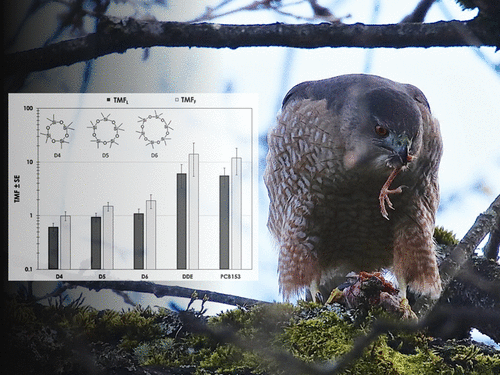当前位置:
X-MOL 学术
›
Environ. Sci. Technol.
›
论文详情
Our official English website, www.x-mol.net, welcomes your
feedback! (Note: you will need to create a separate account there.)
Fugacity-Based Trophic Magnification Factors Characterize Bioaccumulation of Cyclic Methyl Siloxanes within an Urban Terrestrial Avian Food Web: Importance of Organism Body Temperature and Composition
Environmental Science & Technology ( IF 10.8 ) Pub Date : 2021-09-30 , DOI: 10.1021/acs.est.1c04269 Katharine M Fremlin 1 , John E Elliott 1, 2 , Pamela A Martin 3 , Tom Harner 4 , Amandeep Saini 4 , Frank A P C Gobas 1, 5
Environmental Science & Technology ( IF 10.8 ) Pub Date : 2021-09-30 , DOI: 10.1021/acs.est.1c04269 Katharine M Fremlin 1 , John E Elliott 1, 2 , Pamela A Martin 3 , Tom Harner 4 , Amandeep Saini 4 , Frank A P C Gobas 1, 5
Affiliation

|
Trophic magnification of cyclic volatile methyl siloxanes (cVMS) in a terrestrial food web was investigated by measuring concentrations of octamethylcyclotetrasiloxane (D4), decamethylcyclopentasiloxane (D5), and dodecamethylcyclohexasiloxane (D6) and two reference chemicals within air and biota samples from an avian food web located in a mixed urban–agricultural landscape. Terrestrial trophic magnification factors derived from lipid normalized concentrations (TMFLs) for D5 and D6 were 0.94 (0.17 SE) and 1.1 (0.23 SE) and not statistically different from 1 (p > 0.05); however, the TMFL of D4 was 0.62 (0.11 SE) and statistically less than 1 (p < 0.001). TMFLs of PCB-153 and p,p’-DDE were 5.6 (2.2 SE) and 6.1 (2.8 SE) and statistically greater than 1 (p < 0.001). TMFLs of cVMS in this terrestrial system were similar to those reported in aquatic systems. However, trophic magnification factors derived on a fugacity basis (TMFFs), which recognize differences in body temperature and lipid composition between organisms, were greater than corresponding TMFLs primarily because a temperature-induced thermodynamic biomagnification of hydrophobic chemicals occurs when endothermic organisms consume poikilothermic organisms. Therefore, we recommend that biomagnification studies of food webs including endothermic and poikilothermic organisms incorporate differences in body temperature and tissue composition to accurately characterize the biomagnification potential of chemicals.
中文翻译:

基于逸度的营养放大因子表征城市陆地鸟类食物网中环状甲基硅氧烷的生物积累:生物体体温和组成的重要性
通过测量八甲基环四硅氧烷 (D4)、十甲基环五硅氧烷 (D5) 和十二甲基环六硅氧烷 (D6) 以及来自鸟类食物网的空气和生物群样品中的两种参考化学品的浓度,研究了陆地食物网中环状挥发性甲基硅氧烷 (cVMS) 的营养放大率位于城市与农业的混合景观中。来自D5 和 D6 的脂质归一化浓度 (TMF L s) 的陆地营养放大因子分别为 0.94 (0.17 SE) 和 1.1 (0.23 SE),与 1 无统计学差异 ( p > 0.05);然而,D4的 TMF L为 0.62 (0.11 SE),统计上小于 1 ( p < 0.001)。PCB-153 的TMF L s 和p,p'-DDE 分别为 5.6 (2.2 SE) 和 6.1 (2.8 SE),并且在统计学上大于 1 ( p < 0.001)。该陆地系统中 cVMS 的TMF L s 与水生系统中报告的相似。然而,基于逸度的营养放大因子 (TMF F s) 识别生物体之间体温和脂质成分的差异,大于相应的 TMF Ls 主要是因为当吸热生物消耗变温生物时,疏水化学物质的温度诱导的热力学生物放大发生。因此,我们建议对包括吸热和变温生物在内的食物网进行生物放大研究,结合体温和组织成分的差异,以准确表征化学品的生物放大潜力。
更新日期:2021-10-19
中文翻译:

基于逸度的营养放大因子表征城市陆地鸟类食物网中环状甲基硅氧烷的生物积累:生物体体温和组成的重要性
通过测量八甲基环四硅氧烷 (D4)、十甲基环五硅氧烷 (D5) 和十二甲基环六硅氧烷 (D6) 以及来自鸟类食物网的空气和生物群样品中的两种参考化学品的浓度,研究了陆地食物网中环状挥发性甲基硅氧烷 (cVMS) 的营养放大率位于城市与农业的混合景观中。来自D5 和 D6 的脂质归一化浓度 (TMF L s) 的陆地营养放大因子分别为 0.94 (0.17 SE) 和 1.1 (0.23 SE),与 1 无统计学差异 ( p > 0.05);然而,D4的 TMF L为 0.62 (0.11 SE),统计上小于 1 ( p < 0.001)。PCB-153 的TMF L s 和p,p'-DDE 分别为 5.6 (2.2 SE) 和 6.1 (2.8 SE),并且在统计学上大于 1 ( p < 0.001)。该陆地系统中 cVMS 的TMF L s 与水生系统中报告的相似。然而,基于逸度的营养放大因子 (TMF F s) 识别生物体之间体温和脂质成分的差异,大于相应的 TMF Ls 主要是因为当吸热生物消耗变温生物时,疏水化学物质的温度诱导的热力学生物放大发生。因此,我们建议对包括吸热和变温生物在内的食物网进行生物放大研究,结合体温和组织成分的差异,以准确表征化学品的生物放大潜力。











































 京公网安备 11010802027423号
京公网安备 11010802027423号